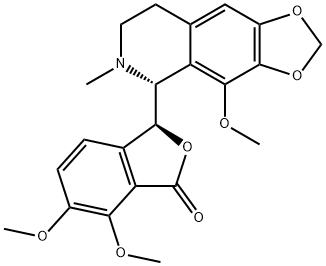Narcotine , ≥97% , 128-62-1
Synonym(s):
(S,R)-Noscapine
CAS NO.:128-62-1
Empirical Formula: C22H23NO7
Molecular Weight: 413.42
MDL number: MFCD00069316
EINECS: 204-899-2
| Pack Size | Price | Stock | Quantity |
| 10mg | RMB64.80 | In Stock |
|
| 50mg | RMB207.20 | In Stock |
|
| 250mg | RMB768.00 | In Stock |
|
| 1g | RMB2208.00 | In Stock |
|
| others | Enquire |
PRODUCT Properties
| Melting point: | 174-176 °C(lit.) |
| alpha | -200 º (c=1 in chloroform) |
| Boiling point: | 532.6°C (rough estimate) |
| Density | 1.395 |
| refractive index | 1.5614 (estimate) |
| storage temp. | -20°C Freezer, Under Inert Atmosphere |
| solubility | Practically insoluble in water, soluble in acetone, slightly soluble in ethanol (96 per cent). It dissolves in strong acids; on dilution of the solution with water, the base may be precipitated. |
| pka | 7.8(at 25℃) |
| color | Orthorhombic prisms or stout needles from alc |
| optical activity | [α]20/D 200°, c = 1 in chloroform |
| Water Solubility | 302.9mg/L(25 ºC) |
| Merck | 13,6752 |
| NIST Chemistry Reference | Narcotine alkaloid(128-62-1) |
| EPA Substance Registry System | 1(3H)-Isobenzofuranone, 6,7-dimethoxy-3-[(5R)-5,6,7,8-tetrahydro-4-methoxy-6-methyl-1,3-dioxolo[4,5-g]isoquinolin-5-yl]-, (3S)- (128-62-1) |
Description and Uses
A major constituent of opium (Papaver sornni!erurn), this phthalideisolquinoline
base was probably first discovered by Derosne, but initially characterized by
Robiquet who gave it the formula C23H3S0 7N, changed to that now accepted by
Matthiesen and Foster. It crystallizes in colourless needles from EtOH and has
[α]D - 198° (c 1.0, CHC13); - 146° (c 2.0, toluene); - 147° (c 1.59, C6H6) and
+ 50° (1 % HCl). The alkaloid is a weak, monoacidic, tertiary base, forming
unstable salts with acids which are dissociated with H20. The hydrochloride
crystallizes with varying amounts of H20, is very soluble in water, readily
decomposing into basic salts on standing. The platinichloride is amorphous; the
oxalate has m.p. 174°C;[α]20D
+ 39.5° (H20); the phthalate, m.p. 160°C;
[α]22D + 115° (CHC13); sesquisulphate, colourless crystals of the hexahydrate and
the picrate, m.p. 1 74-S°C. The (+)-bromocamphorsulphonate has m.p. 110-
120°C; [α]D + 100.7° (CHC13) and the corresponding (-)-bromocamphorsul_x0002_phonate, m.p. l80.SoC; [α]D + 29° (CHC13). The alkaloid yields an N-oxide
which is a hygroscopic solid; [α]D + 135° (CHC13) furnishing a crystalline
hydrochloride, m.p. 193°C; platinichloride, m.p. 175°C and a picrate, m.p.
130°C.
The base is unstable to heat and when heated in a sealed tube yields a mixture
of dimethylnornarcotine, methylnornarcotine and nornarcotine. On heating with
H20 and 150°C, or on boiling with dilute acids, it is hydrolyzed to opianic acid
and hydrocotarnine. Similar degradations are brought about by acid oxidation orreduction, e.g. Zn and dilute HCl gives hydrocotarnine and meconin while dilute
HN03 yields cotarnine and opianic acid. Pharmacologically, narcotine resembles
thebaine (q.v.) in its action, being a reflex stimulant rather than a narcotic.
Antitussive.
Safety
| Symbol(GHS) |  GHS07 |
| Signal word | Warning |
| Hazard statements | H302-H336 |
| Precautionary statements | P301+P312+P330 |
| Hazard Codes | Xn |
| Risk Statements | 22 |
| Safety Statements | 24/25 |
| RIDADR | 1544 |
| WGK Germany | 3 |
| RTECS | RD2625000 |
| HazardClass | 6.1(b) |
| PackingGroup | III |
| HS Code | 29329990 |
| Hazardous Substances Data | 128-62-1(Hazardous Substances Data) |
| Toxicity | cyt-ham:lng 100 mg/L ATSUDG (4),41,80 |




